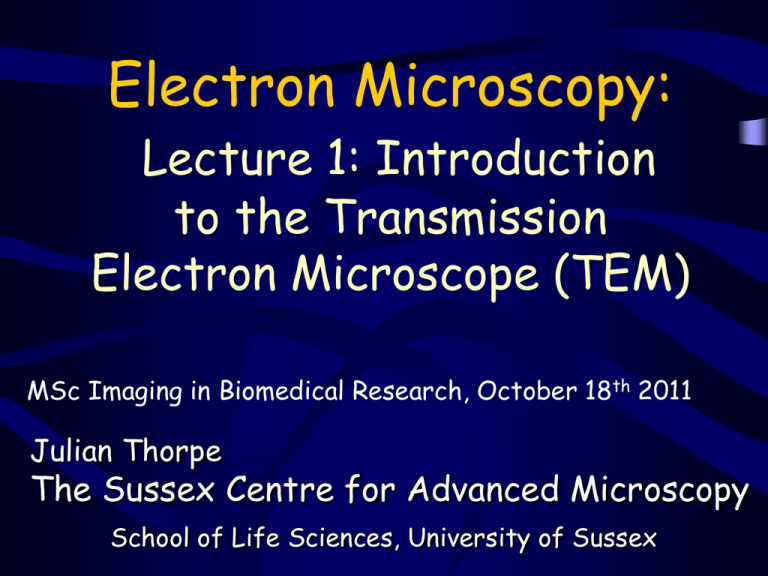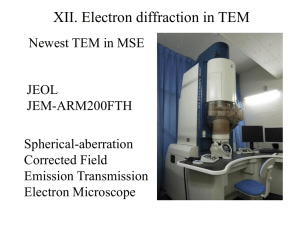Introduction to TEM - School of Life Sciences
advertisement

Electron Microscopy: Lecture 1: Introduction to the Transmission Electron Microscope (TEM) MSc Imaging in Biomedical Research, October 18th 2011 Julian Thorpe The Sussex Centre for Advanced Microscopy School of Life Sciences, University of Sussex Why use electron microscopes (EMs)? Transmission electron microscopes (TEMs) utilise electrons as their source of illumination which gives much improved resolution over a light microscope (around a thousand-fold better: c. 0.2nm compared with 0.2mm) this is mainly because the effective wavelengths of accelerated electrons are extremely shorter than those of light Transmission EMs As the name suggests, the electron beam is transmitted through the sample (normally a thin section of tissue or cells or a particulate sample such as viruses or proteins) so that the fine structure of the specimen may be observed (e.g. cellular ultrastructure) An electron beam has wave-like properties In 1923 de Broglie showed that an electron beam has wave-like properties…… ……thus pointing the way forward to the possible development of electron microscopes Early development of EMs 1928-1931: Knoll and Ruska, in Berlin, began development of electron lenses and built a prototype EM 1937: Metropolitan Vickers Company (Manchester, UK) supply first commercial EM (to Louis Martin at Imperial College, London), but its resolution was no better than that of a LM Late 1930s: a resolution of about 7nm is achieved Early development of EMs 1948-1953: The ultramicrotome was developed, allowing cutting of ultrathin (60-100nm) sections This was important, as electrons have limited energy and cannot pass through sections of more than a few hundred nm (except for high voltage TEMs) Gas or water molecules would also obstruct the passage of electrons down the ‘column’ of the TEM, thus they operate under a high vacuum Effective wavelengths in the TEM l = (1.5/V)1/2 nm where V = the accelerating voltage of the electron beam Voltage l 25,000 0.0077nm 50,000 0.0055nm 75,000 0.0045nm 100,000 0.0039nm 200,000 0.0027nm 1,000,000 0.0012nm 3,000,000 0.0007nm Effective wavelength decreases with increased accelerating voltage Resolution in the TEM Resolution (nm) = 0.61 X l /N.A. where N.A. = the numerical aperture of the objective lens l N.A. Resolution 25,000 0.0077nm 0.01 0.47nm 50,000 0.0055nm 0.01 0.33nm 75,000 0.0045nm 0.01 0.27nm 100,000 0.0039nm 0.01 0.24nm 200,000 0.0027nm 0.01 0.17nm 1,000,000 0.0012nm 0.01 0.07nm 3,000,000 0.0007nm 0.01 0.04nm Voltage Resolution improves with increased accelerating voltage (and associated shorter effective wavelength) Resolution in a ‘standard’ TEM vs LM Comparing a ‘standard’ TEM of 100kV accelerating voltage with a light microscope using UV illumination and optimal objective lens numerical aperture l 100kV TEM 0.0039nm UV light 365nm N.A. Resolution 0.01 0.24nm 1.40 159nm Although the wavelength of the illumination source in the TEM is 5 orders of magnitude shorter, numerical apertures of LM lenses are much greater Life Sciences TEM: Hitachi-7100 (<125kV; resolution = 0.204nm) A Million Volt TEM (resolution = 0.07nm) 3 Million Volt Hitachi: the most powerful TEM ever made (resolution = 0.04nm) 3 Million Volt Hitachi: the most powerful TEM ever made(resolution = 0.04nm) Operator The way TEMs are going? HT7700 120 kV biomedical TEM from Hitachi 100% integration of all functions into the graphical user interface http://www.youtube.com/watch?v=h6VkvseFkzQ Resolution in a ‘standard’ 100kV TEM Optical Microscope resolution c. 200nm TEM resolution c. 0.2nm Resolution in the TEM 500nm Resolution in the TEM 200nm Resolution in the TEM 100nm The electron beam source The electron beam is routinely derived from a thin hairpin filament of tungsten wire housed in a gun assembly A high accelerating voltage is used to boil electrons off the tip of the tungsten wire by thermionic emission and these are fired down the column of the EM and focused by electromagnetic lenses The electron source (Cathode Gun Assembly) Figure c/o: http://en.wikipedia.org/wiki/Transmission_electron_microscopy The electron source A high accelerating voltage is supplied to the filament Figure c/o: http://en.wikipedia.org/wiki/Transmission_electron_microscopy The electron source Electrons are boiled off the tip of the filament by ‘thermionic emission’ Figure c/o: http://en.wikipedia.org/wiki/Transmission_electron_microscopy The electron source The ‘Wehnelt cylinder’ has a higher –ve charge than the filament Figure c/o: http://en.wikipedia.org/wiki/Transmission_electron_microscopy The electron source The ‘Wehnelt cylinder’ has a higher –ve charge than the filament……. and thus focuses the electrons Figure c/o: http://en.wikipedia.org/wiki/Transmission_electron_microscopy The electron source Electrons are attracted to the positively charged ‘anode plate’ and pass through an aperture within it Figure c/o: http://en.wikipedia.org/wiki/Transmission_electron_microscopy Transmission EMs CrossSection through the Column of a TEM (side view) The TEM ‘column’ stands vertically with a cathode gun assembly at the top housing the tungsten filament Electrons are boiled off the tip of this filament by ‘thermionic emission’ when a high voltage is applied Transmission EMs CrossSection through the Column of a TEM (side view) Beneath this is an anode plate, to which electrons are attracted and an aperture allows their passage down the TEM column Transmission EMs CrossSection through the Column of a TEM (side view) The TEM column is maintained under a high vacuum as electrons have insufficient energy to pass through gas and water molecules This vacuum is achieved usually via oil diffusion pumps, backed up by rotary pumps Transmission EMs CrossSection through the Column of a TEM (side view) A series of leadshrouded and water-cooled electromagnetic lenses make up the bulk of the TEM column Transmission EMs CrossSection through the Column of a TEM (side view) Condenser lenses condense and focus the electrons onto the area of the specimen being examined Transmission EMs CrossSection through the Column of a TEM (side view) An objective lens surrounding the specimen insertion area primarily focuses and initially magnifies the image Transmission EMs CrossSection through the Column of a TEM (side view) Intermediate and projector lenses magnify and project the focused image onto the fluorescent screen (converts electrons to photons) at the base of the column or to a CCD camera beneath that Transmission EMs Electromagnetic lens defects are similar to those of optical lenses… …and these detract from achievement of the maximum theoretical resolution. They are: 1. Spherical aberration: Electrons passing through the lens periphery are refracted more than those passing along the lens axis and therefore do not have the same focal point. Apertures are used in the TEM to limit the peripheral electrons and minimise this aberration Transmission EMs Electromagnetic lens defects are similar to those of optical lenses… 2. Chromatic aberration: electrons of different energies converge at different focal points and this is essentially equivalent to chromatic aberration in light microscopy This can be minimised by: • increasing the accelerating voltage • an improved vacuum • use of the thinnest possible specimen Transmission EMs Electromagnetic lens defects are similar to those of optical lenses… 3. Astigmatism: occurs when the field within the electromagnetic lens is not perfectly symmetrical. Can be due to imperfect boring of the lens polepieces or contamination of the column, specimen or apertures .....TEMs have astigmatism controls to correct for this Preparation of biological samples for TEM • Fixation: ‘Greater care’ needed for samples prepared for TEM, owing to the improved resolution and the higher magnifications possible • Samples have to be dry* (as the TEM operates under a high vacuum): therefore samples are dehydrated (* the exception to this are frozen-hydrated samples viewed by cryo-TEM) • Samples have to be ultrathin: this is because of the limited energy of the electron beam Therefore: • special resins designed to allow cutting of ultrathin (c.50100nm) sections are used to infiltrate and ‘embed’ samples • Or small particulates may be viewed (after air-drying) Preparation of biological samples for TEM • Fixation: Normally a double-fixation in buffered glutaraldehyde (c.2-5%; cross-links proteins) and subsequently osmium tetroxide (1%; imparts electrondensity to lipidic components) • Dehydrate: in an ethanol series • Resin embedding: infiltration with epoxy resin for a few days and heat-polymerised • Thin sectioning: must be ‘ultrathin’ to allow the electron beam to transmit through the section Thin sectioning/’Ultramicrotomy’ • Sections of c. 60-100nm are cut on an ultramicrotome and collected on TEM support ‘grids’ <<< 3mm >>> Staining to Achieve Contrast Contrast in thin sections examined in the TEM is facilitated by the use of heavy metals that can occlude and absorb electrons. These are routinely: • Osmium tetroxide: when used as a secondary fixative imparts electron-density to the lipidic component, especially membranes • Uranyl acetate and lead citrate: are used as ‘poststains’. The former binds nucleic acids and proteins and the latter subsequently enhances the contrast ‘Negative staining’ of particulate samples • A very simple but effective method to examine particulate samples at high resolution • A drop of the sample is aliquotted onto a coated TEM support grid • A drop of heavy metal stain (e.g. uranyl acetate) is then dropped onto the sample and allowed to dry down around it • When viewed under the TEM the sample appears to be negatively-stained as the heavy metal creates an electron-dense background Negative Staining bacteriophage Life Sciences TEM: Hitachi-7100 (<125kV; resolution = 0.204nm) High voltage supply cable Electron gun region TEM column Specimen airlock Viewing screen area plus binoculars Hitachi-7100 TEM Specifications: • Accelerating voltage range: 25 – 125kV • Magnification ranges: • 50 – 1,000X in ‘low mag’ mode • 1,000 – 600,000X in ‘zoom’ mode • Resolution: 0.204nm (lattice)/0.45nm (particle) • Motorized and tilting specimen stage with ‘memorise’ and ‘relocate’ specimen positions facilities TEM image formation Image and contrast formation results from electrons that are: • non-transmitted (occluded by the heavy metal stains) • scattered (elastic and inelastic) • unscattered (transmitted) TEM image formation Elastically scattered electrons (by the nucleus of an atom) contribute mostly to image contrast TEM image formation Inelastically scattered electrons are concentrated within smaller scattering angles TEM image formation Unscattered (or transmitted) electrons will pass through the specimen to form the electron-lucent regions of the image TEM image formation Higher accelerating voltages result in: • Increased electron speed and a concomitant decrease in the incidence of inelastic scattering • So, although resolution is improved (because of the shorter effective wavelengths), contrast is lowered This can be redressed by the use of smaller apertures in the objective lens, but at the expense of some lowering of the resolution TEM image formation Condenser lens aperture Objective lens aperture Or CCD camera TEM imaging CCD camera Gatan Ultrascan 1000 CCD Camera Gatan Ultrascan 1000 CCD Camera Specifications: • CCD active area 28.7mm X 28.7mm • 2048 X 2048 pixels (14mm each) • 16-bit digitization • Binning 1,2,3,4,6 and 8X • CCD readout: full or sub area • Readout speed: 4MPix/sec (4-port parallel) • Scintillator: standard phosphor • Coupling: fibre optic (1:1) • Mounting position: on axis bottom port • Peltier cooling –25deg C regulated Gatan Ultrascan 1000 CCD Camera Camera workstation alongside TEM Camera controller (with low noise electronics and high speed read-out at 4 megapixels per second) TEM imaging TEM imaging TEM imaging to reveal ‘ultrastructure’ of cells & particulates Useful Links My TEM Website (includes information on sample preparation, methodologies, TEM instructions, image galleries, etc.): University of Iowa ‘Central Microscopy Research Facility’ (excellent site for background on TEM): University of Liverpool ‘Matter’ (excellent site for background on electron optics, with many interactive features): Reimer and Kohl (2008) (online book ‘Transmission electron microscopy: physics of image formation’) University of Georgia ‘Centre for Advanced Ultrastructural Research’ (excellent powerpoint on intermediate to high voltage TEM): Videos Structure and Function of the TEM The TEM: part 1 The TEM: part 2








